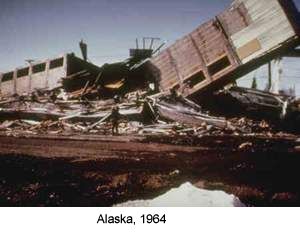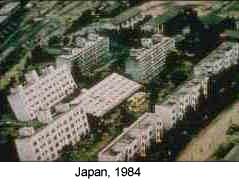BACKGROUND:
It sometimes does not matter the intensity of the
earthquake, but how the structures can withstand the force of the shaking.
Sometimes landslides or tsunamiís caused by the energy destroys an area.
Below are some examples of such disasters.
 The
southern Alaskan earthquake on March 27, 1964 had a 8.3 magnitude. It caused
severe damage due to landslides and from a large tsunami wave that hit the
area. Many homes and businesses were damaged because the structures could
not withstand the mass movement.
The
southern Alaskan earthquake on March 27, 1964 had a 8.3 magnitude. It caused
severe damage due to landslides and from a large tsunami wave that hit the
area. Many homes and businesses were damaged because the structures could
not withstand the mass movement.
A moderate earthquake (5.5) in Peru in 1962 caused
complete damage to villages. The unreinforced adobe and wood structures
could not withstand the shaking. The intensity of the earthquake was not
great, but the damage was.
 On
June 16, 1984 a large earthquake was felt in the Nigata region in Japan. Large
buildings collapsed due to the shaking. In some areas the ground was
unstable and caused buildings to tumble.
On
June 16, 1984 a large earthquake was felt in the Nigata region in Japan. Large
buildings collapsed due to the shaking. In some areas the ground was
unstable and caused buildings to tumble.
A 6.4 earthquake in San Fernando
Valley region, just north of Los Angles, caused major damage to hospitals,
homes, and freeways. After this earthquake, California created strict laws
so builders would make earthquake resistant buildings.
In September, 1985, two large earthquakes (8.1 and
7.3) paralyzed Mexico City. Residents had no clean water for weeks. Large
buildings collapsed, and people were trapped. Mexico did not use reinforced
concrete structures, which could not take the intense shaking.
In Sumatra-Andaman Islands there was a devastating
earthquake (9.0) on December 26, 2004. It occurred on the interface of the India and Burma plates and was caused by the release of stresses that develop as the India plate subducts beneath the
Burma plate. At least 80,000 people were killed by the earthquake and tsunami in Indonesia. Tsunamis killed at least 41,000 people in Sri
Lanka and10,000 in India. A total of over 150,000 people died mainly by a
tsunami that hit the low lying areas along the rim of the Indian Ocean.
PROCEDURE:
- In this exercise, students experiment with structures. They design and
build models composed of different types of materials on shaker tables,
and then simulate earthquakes of various strengths to test their
designs.
- If necessary, gather the materials to make shaker boards before lab.
Boards should be about 12 x 18 inches (or longer than they are wide),
with at least 3/4 inch thickness.
- Place the marbles in a plastic top that you might get in a coffee
can. The marbles will act as ball-bearings in the experiment.
- Balance the shaker board on top of the marbles. This completes the
shaker table.
- Demonstrate how the shaker board works to the class. When it is
"jolted", it simulates the movement of the Earth's surface (an
earthquake). The "earthquake" creates energy that moves along
the surface of the shaker table as waves. Control the intensity by how
fast you shake the board. Demonstrate to students that a strong
earthquake occurs when you shake quickly; a weak earthquake occurs when
you shake it less violently; a moderate earthquake occurs when you shake
it somewhere in between. On the lab worksheet, "slow-long"
means to move the board in the long direction slowly (this is relative).
"Quick-long" refers means moving the board in the long
direction quickly. This will illustrate that intensities B and D (both
quick) represent a high number on the Richter Scale while A and C
represent a low Richter number.
- Using a different building block set at each station, have the
students build an "earthquake proof" structure. Next, have
them place different "real life" models in and outside their
structures. Test the models using the four intensities and have students
record their results.
- Have students discuss their results. Have them analyze why some
students recorded different amounts of damage. They should realize that
the building materials are an important factor. In addition, their
structures lack foundations which in general will make them less stable
than real buildings.
- You can extent this lab very easily by having the students redesign
their structure to try and make it more resistant. You may want to go
over more resistant shapes that the students learned in a previous lab.
You may also want to describe the different types of reinforcement of
structures.